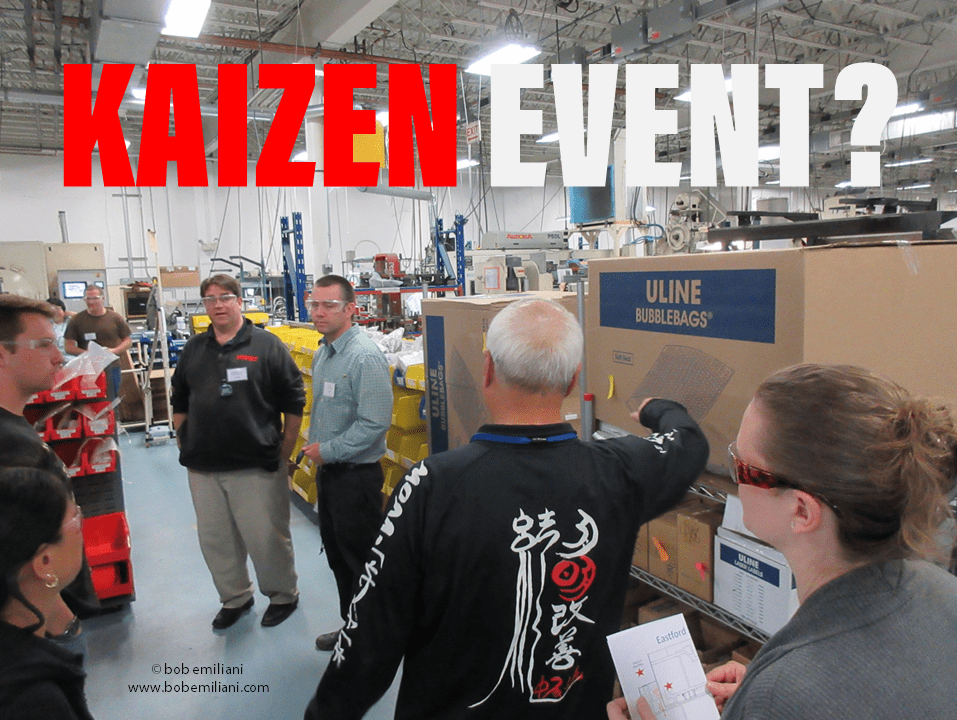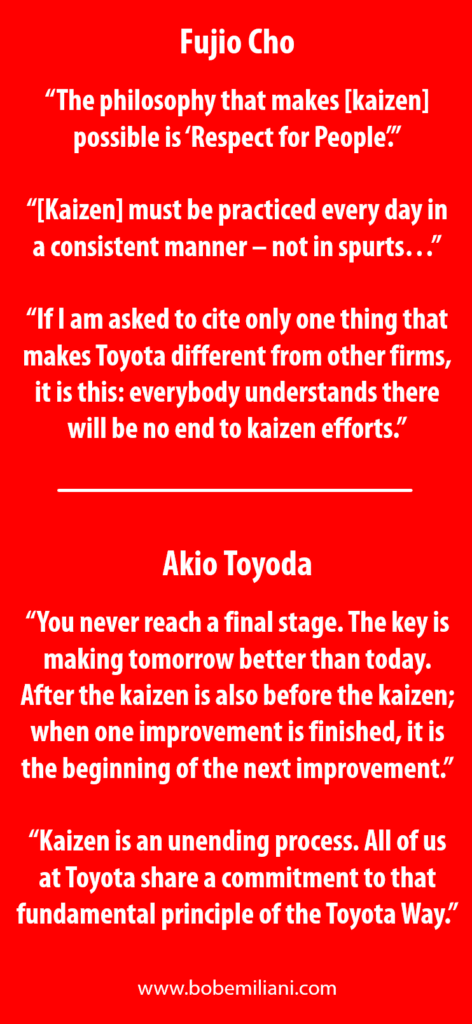
Where did the phrase “kaizen event” come from? Or, more accurately, who added the word “event” to the word “kaizen?”
In Japan, the word “kaizen” is used with no additional modifier. Kaizen means “change for the better.” But, the context for “change for the better” is multilateral, meaning change must be good for everyone (non-zero-sum outcome for both internal and external stakeholders), not good for you and bad for me (a zero-sum trade-off). The latter is major error in understanding, one that results in bad kaizen practice. Read “Toyota’s Secret” and Toyota Kaizen Methods to understand what kaizen is and how to correctly practice it.
Many in the Lean community think the phrase “kaizen event” was coined by Shingijutsu kaizen consultants when they first arrived in the United States in 1987. It did not originate with Shingijutsu kaizen consultants, but the phrase “kaizen event” was inspired by Shingijutsu’s work.
When I was doing research for the book Better Thinking, Better Results in 2002, I interviewed the late Bill Moffitt (Bill wrote the Foreword to Better Thinking). Bill was a long-time engineering and operations manager at The Jacobs Chuck Manufacturing Company, a unit of Chicago Pneumatic. Danaher Corporation bought Jacobs Chuck in 1984. The first Shingijutsu kaizen consulting engagement in the United States was at Jacobs Chuck in Clemson, South Carolina, in August 1987, which Bill participated in.
Since Bill was there at the start, I asked him if he knew where the phrase “kaizen event” came from. I asked the question because my kaizen teachers (same as Bill’s) taught me that kaizen was a daily activity, not an “event.” The words “kaizen event” were commonly interpreted by managers as a periodic activity, not a continuous activity. That bothered me. In addition, I could see in my own manufacturing facility that the pace of improvement was slow when kaizen was periodic and much faster when it was part of people’s daily activities.
To my surprise, Bill told me he thought that he coined the phrase “kaizen event.” That was his recollection. Whether it was Bill or someone else, the key point to recognize is that “kaizen event” came from kaizen consulting clients, not from the kaizen consultant, Shingijutsu. And it is easy to see why. For the clients, kaizen was new to them, and hence an “event.” In addition, kaizen consultants traveling all the way from Japan to the United States would not spend half a day or one day facilitation kaizen and go then home. It would not make sense to do that. Instead, the kaizen consultant stayed for 5 days and facilitated 3 to 5 kaizens at the same time at the client’s site. This reinforced the idea among clients – managers, kaizen team members, and other employees – that kaizen was an “event.”

Of course, Shingijutsu never called kaizen an “event.” For them, kaizen was an everyday activity, and the kaizen consultants worked hard to get clients to understand that. They would say often to managers and kaizen team members that kaizen is a daily activity and what was learned during the kaizen week must be applied every day after the kaizen consultant leaves. Things change every day, so improvement must take place every day. Shingijutsu consultants are very clear on the need for daily practice – to “master the basics” – to improve one’s capabilities to innovate and improve. They also make clear how kaizen is fundamental for learning and the development of human potential. Sensei Chihiro Nakao says:
“Listening and understanding is not enough. You have to practice it [kaizen]. It has to become your skill, your philosophy, and your knowledge. That is how you evolve and develop your own path.”
Unfortunately, the phrase “kaizen event” has proven to be powerful and durable. It has anchored vast numbers of people into thinking of kaizen as a periodic activity. Maybe it is because people prefer to engage in kaizen on a periodic basis, instead of a daily basis, to make life at work easier for themselves – to have long intervals of rest and relaxation between kaizen “events.” But, what they don’t realize is that by doing so they make life at work much harder on themselves – and everyone else (suppliers, customers, and investors). It is no surprise, then, that most Lean efforts fall well short of expectations if not fail completely. Not only is kaizen infrequent, it is usually conducted incorrectly.
The irony is that Bill Moffitt clearly understood kaizen to be a daily activity, just as he was trained to understand it by Shingijutsu consultants. His characterization of kaizen as “kaizen event” was an initial impression after the first kaizens in August 1987, not a lasting impression. In fact, Bill worked for Art Byrne as head of Danaher’s new Just-In-Time (later, Kaizen) promotion office in the late 1980s, to make kaizen a daily activity at Danaher. Upon his retirement in 1991, Bill formed Moffitt Associates to teach kaizen to others.
Other ways of describing kaizen are “kaizen blitz” and “kaizen burst.” These have proven to be powerful and durable – and also incorrect. There is a big lesson to be learned here: How terms are understood (or modified) matters because that informs practice. Bad understanding results in bad practice and poor outcomes.
Shingijutsu uses the phrase “kaizen workshop” to describe the multi-day kaizens that they facilitate. The word “workshop” is intended to signify that kaizen facilitated by a sensei is a focused learning experience for kaizen team participants and whose teachings must be applied in practice after the workshop ends. It is training in industrial engineering methods that must result in actual practice.
Kaizen is not an event. Kaizen is not a blitz. Kaizen is not a burst. Kaizen is kaizen. Just say “kaizen” and practice it correctly every day.
